We offer this Saints Novena in gratitude for the ways God lives and moves and has being in the lives of all the saints who are part of this online community. We give thanks for you and for the gift of God that you are to us and to the world. It is because of people like you that there is this awesome place of hospitality and gospel community. This novena is written by the A Nun’s Life Community.
Day 1 Saints Novena – Mary our Sister – by “Bcoop”
Reflection: With an elevated title like “Mother of God”, we might forget that Mary was a young Jewish girl from Palestine. She lived in a Country dominated by a foreign power, knew the violence of occupation, of fear, of anger at injustice, and probably joined in lamenting the slowness of Israel’s God in rescuing the people. Mary spent her days doing the routine stuff of life, like going to the village well to draw water for her family or learning to cook as her mother did. She went to the Temple as the Law of Moses prescribed. She learned to listen to what was in her heart. One day, she became pregnant with new life and we all know where that 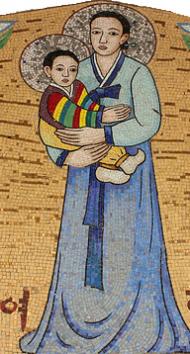 led. We might think that because she was Jesus’ mother she is elevated beyond anything we might aspire to. But when Jesus praises her, it is because she had open ears and a responsive heart to God’s Word.
led. We might think that because she was Jesus’ mother she is elevated beyond anything we might aspire to. But when Jesus praises her, it is because she had open ears and a responsive heart to God’s Word.
Like Mary we are pregnant with God’s own life. We are called to give birth to that life in our world and our circumstances. Mary shows us the way in her example of hearing God’s Word and acting with it.
Prayer: Be our companion on this journey dear sister Mary. Teach us the ways of wisdom as you taught your son Torah. Encourage us by your strength, inspire us by your attentiveness, and be our midwife in witnessing to Christ in our life.
Suggested Reading:
- Truly Our Sister: A Theology of Mary in the Communion of Saints by Elizabeth A. Johnson
- Dangerous Memories: A Mosaic of Mary in Scripture by Elizabeth A Johnson
- Miryam of Judah: Witness in Truth and Tradition by Ann Johnson
Day 2 Saints Novena – Josephine Bakhita – by Sister Maxine
 Reflection: St. Josephine Bakhita shows us that forgiveness and freedom walk hand in hand. Kidnapped into slavery as young girl in Sudan, Bakhita was sold and re-sold in African slave markets. The name, Bakhita, meaning “Fortunate One,” was given to her by her kidnappers.
Reflection: St. Josephine Bakhita shows us that forgiveness and freedom walk hand in hand. Kidnapped into slavery as young girl in Sudan, Bakhita was sold and re-sold in African slave markets. The name, Bakhita, meaning “Fortunate One,” was given to her by her kidnappers.
Bakhita faced great physical, spiritual, and emotional adversity during her enslavement. But even these experiences could not destroy the seeds of hope and transformation that lived in Bakhita.
Eventually, Bakhita was purchased by a family that, by the standards of the times, treated her kindly. She later moved to Italy with the family, and there she met the Canossian Daughters of Charity. With them, she began her journey into the Catholic faith and was baptized. The sisters were among those who helped Bakhita, baptized as “Josephine,” achieve her freedom, and soon she entered the congregation.
St. Josephine forgave her kidnappers and captors. They had caused enormous pain in her life, yet she chose forgiveness. In doing so, she rejected hate, anger, fear, and revenge—emotions that, in themselves, enslave people and rob their capacity for joy.In forgiving others, St. Josephine chose freedom, and in her freedom, she found joy.
Prayer: Walk with us, St. Josephine Bakhita, at times when we feel unable to forgive others. Help us find our way through the pain we’ve experienced. Help us open ourselves to transformation. Free us from that which can enslave us. Walk with us into a new place of joy.
Suggested Reading:
Day 3 Saints Novena – Theresa Maxis Duchemin and Louis Florent Gillet – by Sister Julie
 Reflection: Saints take many forms, canonical and otherwise. In today’s novena we celebrate all the saints who have gone before us “marked with the sign of faith,” those who may not be canonized but who have had a profound influence on our lives. Today we honor two such saints, founders of the religious congregations of the Sisters, Servants of the Immaculate Heart of Mary.
Reflection: Saints take many forms, canonical and otherwise. In today’s novena we celebrate all the saints who have gone before us “marked with the sign of faith,” those who may not be canonized but who have had a profound influence on our lives. Today we honor two such saints, founders of the religious congregations of the Sisters, Servants of the Immaculate Heart of Mary.
While general superior of the Oblate Sisters of Providence, Theresa Maxis Duchemin met the Redemptorist missionary Louis Florent Gillet, who was seeking women religious for schools in the still new State of Michigan. After much discernment, Theresa agreed to help Gillet found a new congregation in Monroe. On November 10, 1845, Theresa along with Charlotte Schaaf and Therese Renaud, became the first members of a new religious community dedicated to education in the frontier land of Michigan.
In January 1846, they opened St. Mary’s Academy in Monroe. As the community and mission grew, Father Gillet was forced to leave and return to Europe in 1847. Though flourishing, the community struggled to deal with Louis’ departure and their struggle worsened with a sudden separation from Theresa. Theresa was caught in the middle of a jurisdictional dispute about the congregation between the bishops of Philadelphia and Detroit. The bishop of Detroit held Theresa responsible, deposed her as General Superior, and sent her to the Pennsylvania foundation, which later became a separate branch of the congregation. Despite these trials, the new community persisted in its Redemptorist spirit of humility, simplicity, and zeal.
Theresa and Louis’s legacy of courage, peace and service to the poor continues in now three IHM congregations of Monroe, Michigan, Immaculata, Pennsylvania, and Scranton, Pennsylvania.
Prayer: We pray that we might tap into God’s gifts to each of us of courage, peace, and service, even when it seems the struggles and trials that we bear are too much. We trust with Theresa and Louis, that God will bring all our efforts to good.
“May the same faith and hope and courage of those loved ones who are ‘dwelling now in Light—yet ever near’ inspire us to continue bravely and earnestly the glorious work so nobly begun.” (Mother Theresa McGivney, IHM, November 10, 1945)
Suggested Reading:
- Paths of Daring, Deeds of Hope: Letters by and about Mother Theresa Maxis Ducheminby Sister Margaret Gannon, IHM (Published in Scranton, Pennsylvania, 1992)
- Building Sisterhood: A Feminist History of the Sisters, Servants of the Immaculate Heart of Mary by the IHM Sisters of Monroe, Michigan (Syracuse University Press, 1995)
Day 4 Saints Novena – Saint Francis of Assisi – by Audra
Reflection: Saint Francis of Assisi is one of the most popular saints ever. There have been hundreds of books, several movies and one Broadway play done on this twelfth century saint. But for me, what makes the cool points go through the roof is that Saint Francis has his own comic book- and not just any comic book a Marvel comic book. Yes, that’s right. The kings of the comic books wrote a comic book about Saint Francis.
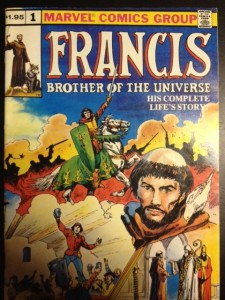 Francis Berandone was born into the middle class but always dreamt of being a knight. He fought in the Perugian War but was captured and put in prison for a year. It was while he was in prison that Francis first began to experience the hints of how God was calling him. In prison, Francis saw how the very men he had respected and served valiantly with were now fighting each other for food. Instead of joining them, he found that he felt joy when he gave food to the other prisoners.
Francis Berandone was born into the middle class but always dreamt of being a knight. He fought in the Perugian War but was captured and put in prison for a year. It was while he was in prison that Francis first began to experience the hints of how God was calling him. In prison, Francis saw how the very men he had respected and served valiantly with were now fighting each other for food. Instead of joining them, he found that he felt joy when he gave food to the other prisoners.
When freed, Francis returned to his partying ways — and was really good at it. When fights between the pope and German princes broke out, he again was lured back to his dream to be a knight. Francis purchased the finest armor and rode with other soldiers to defend the Church. But one night before the war, God told Francis in a dream to return to Assisi. A would-be knight turning away from a fight was more than Francis’ family could bear and they were embarrassed by him. So one day Francis went to Mount Subasio to pray. He didn’t hear God’s voice but felt freer just by praying. Francis prayed intensely for a year but still couldn’t hear God’s voice. Then one day while walking he came upon a leper. At first Francis was scared, but then he felt overwhelmed with compassion and reached out and gave the leper a hug.
Later on, Francis went to the San Damiano church to pray in front of the Crucifix. Suddenly Jesus came alive and told Francis to “rebuild my church.” Francis took this to heart, and did his best to sell his merchant father’s bolts of clothes for building supplies. Unimpressed, his father found out and took him straight to the bishop. Francis’ father asked for the clothes back. Francis obliged, and right then and there took off all of his clothes in front of everyone. This marked Francis’ choice to leave behind all the expectations of his family and his own expectations and follow God.
A few days later Francis’ friend Bernardo asked to join him. Eventually more men joined them. Seeing the numbers grow Francis went to the Pope to ask if he would start a new religious order. The Pope said no, but that night he had a dream that Francis was able to rebuild the church. The next day the Pope gave Francis his blessing.
When Francis returned to Assisi, his friend Clare — yes, THE Clare — came to him asking to join his new order. Francis was hesitant at first, but then told Clare that she could live under the same laws as the Friars. The Poor Clares were born!
A few comic book days later, Francis witnessed the battle of the crusades and decided to speak with the sultan to stop the war. Francis gained the respect of the Sultan and was given a pennant so he could safely travel to all of the holy places of Jesus’ life.
After the trip, Francis came back to find his order … umm… not in order. They forced him to write rules other than the Gospels to live by. So Francis did what he always did when he needed to pray: he headed for the hills. Like Jesus, Francis spent much time in prayer in mountains. There on Mount La Verna he received the Stigmata. He became an instant celebrity as people heard about these extraordinary marks of holiness. Over the next two years Francis’ health deteriorated. As he lay on the death bed Francis said, “Praise the Lord, for our Sister, death whom none can escape. My soul is at peace. I am prepared to meet her. Welcome Sister Death.” Francis died on October 3, 1226.
 Saint Francis to me is an everyday, working person’s type of saint. He was also crazy. Crazy for God that is. I wish I can be that type of crazy. He didn’t care if you were man, woman or beast — you were a child of God and worthy of love. I think that’s why he is also the patron saint of animals. They were his sisters and brothers too.
Saint Francis to me is an everyday, working person’s type of saint. He was also crazy. Crazy for God that is. I wish I can be that type of crazy. He didn’t care if you were man, woman or beast — you were a child of God and worthy of love. I think that’s why he is also the patron saint of animals. They were his sisters and brothers too.
Prayer: A very popular Prayer NOT written by Saint Francis but is something he would say: “God, grant me the serenity to accept the things I cannot change, courage to change the things that I can, and the wisdom to know the difference.”
Suggested Reading:
- “Francis, Brother of the Universe” Comic Book by Marvel
- Life of Saint Francis of Assisi by Saint Bonaventure
Day 5 Saints Novena – Saint Dominic Guzman – by Bcoop
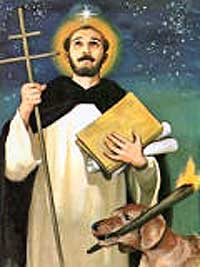 Reflection: While almost everyone knows and loves Francis of Assisi, few are familiar with his contemporary, Dominic de Guzman. Dominic was born about 1170 in Caleruega, a small village in Spain. I could write a biography but you can get that from Google. Instead I’d like to tell you why I love this man.
Reflection: While almost everyone knows and loves Francis of Assisi, few are familiar with his contemporary, Dominic de Guzman. Dominic was born about 1170 in Caleruega, a small village in Spain. I could write a biography but you can get that from Google. Instead I’d like to tell you why I love this man.
As a student Dominic needed and treasured his books. This was before the invention of the printing press so they were laboriously made by hand and couldn’t be replaced at a local book store. When famine struck, Dominic sold his precious books to feed the poor.
He opened himself to the unknown when he saw a need for change. He left what he knew and was comfortable with, and entered into uncertainty to discern the path God was calling him to.
Dominic was cheerful. When he and Francis met I imagine them having some good laughs about wolves and birds, among other things.
Dominic lived outside of “boxes”. He blended and brought things, and people, together rather than separating them.
Perhaps this could be summed up best by what I wrote in my Journal so many years ago:
I think of Dominic – a man of joy and prayer, a man who treasured his friends, and in their common passion for living and preaching the Gospel, deepened in relationship to become “Family”.
Simon Tugwell wrote:
“The faith of God in people makes, every now and then, a person come true.
And then a heart is rhythmed to the very beat of God,
a mind to truth, and a mouth to gospel,
wooing the matter of man to God.”
Prayer:
Joyful Friar
Patient Teacher
Grace-filled Preacher
Gospel man of prayer
Pray for us and walk with us in God’s Way.
Suggested Reading:
- Early Dominicans from Classics of Western Spirituality
- International Dominican website
- Reflections on readings, resources, etc
- Bcoop’s Journal of my pilgrimage to the lands of Dominic)
Day 6 Saints Novena – Latin American Martyrs – by Marla
 Reflection: Wherever great evil thrives, great saints are made. Evil, as in Latin America from forever until today, kills and steals and destroys. It is horrific, but predictable.
Reflection: Wherever great evil thrives, great saints are made. Evil, as in Latin America from forever until today, kills and steals and destroys. It is horrific, but predictable.
Saints like Archbishop Oscar Romero learn great lessons and turn their lives around; Romero himself was martyred for repeatedly calling on the Salvadoran government to love the poor instead of killing them.
The six Jesuit priests along with their cook and her daughter were murdered in their home by US-backed Salvadoran forces in 1989 were guilty of preaching peace and caring for the poorest of the poor.
When the Salvadoran government killed people who spoke up against injustice and left them to rot on the streets, with the understanding that anyone who moved the bodies would be subject to the same treatment, the Four Churchwomen chose to honor the corporal works of mercy taught by the Catholic Church and buried the dead anyway. Just before the three nuns, Ursuline Sister Dorothy Kazel, Maryknoll Sister Ita Ford, and Maryknoll Sister Maura Clarke, along with lay missioner Jean Donovan were murdered and left in a shallow grave, Clarke wondered aloud to her friends, “I know death is coming. Will I be faithful?”
These and other saints from that evil time and place spoke truth to power—even to US power who gave money to the evil Salvadoran armies—and nothing is harder to do when death is chasing you down.
Prayer: Dear Creator, may we, like the Latin American Martyrs, be willing to have our eyes opened and our lives changed. May we ask daily, as Maura Clarke asked on the eve of her murder, “Will I be faithful?” With the other churchwomen, may we be willing to live our faith without fear of reprisal. And with the spirit of all Latin American martyrs and saints, may we be bold enough to speak truth to power even when the truth will cost us. Bless us with your love of justice.
Suggested Reading:
- Companions of Jesus: The Jesuit Martyrs of El Salvador by Jon Sobrino
- Salvador by Joan Didion
- Disturbing the Peace: The Story of Father Roy Bourgeois and the Movement to Close the School of Americas by James Hodge and Linda Cooper
- Salvador Witness: The Life and Calling of Jean Donovan by Ana Carrigan
Day 7 Saints Novena – Dorothy Day – by Bcoop
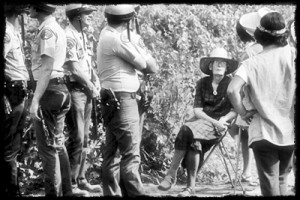 **Image: Dorothy Day on picket line with farm workers in Lamont, California, 1973
**Image: Dorothy Day on picket line with farm workers in Lamont, California, 1973
Reflection: Dorothy Day (born: November 8, 1897; died: November 29, 1980)
I wonder how Dorothy feels about being “nominated for official sainthood”? She is reputed to have said: “Don’t call me a saint. I don’t want to be dismissed so easily.” Saints do run the danger of being “photoshopped” – all their quirks and warts smoothed away until they appear as bland as marshmallows. That might be more difficult to do with Dorothy.
Dorothy’s whole life was marked by concern for the injustices of society and the plight of destitute people. She spent her life joining charity and justice. As she said: “There was a great question in my mind. Why was so much done in remedying social evils instead of avoiding them in the first place? . . . Where were the saints to try to change the social order, not just to minister to the slaves but to do away with slavery?” (Long Loneliness, p. 45)
Dorothy’s first job as a journalist was with the New York Call, a socialist newspaper. Her reporter colleagues were socialists, communists, labour organizers for the American Federation of Labour and the Industrial Workers of the World and various free thinkers and anarchists opposed to conscription and the entry of the United States into World War I.
The labour movement, socialist ideas, and her own experiences of hardship had a strong influence on Dorothy’s commitment to social justice. At the same time, she was searching for some inner connection with the God who was enticing her. Brought up in a nominally Protestant home, Dorothy was drawn to the ritual of the Catholic Church.
In 1927 Dorothy’s daughter, Tamar, was born and was baptized in the Catholic Church. Dorothy said: “I did not want my child to flounder as I had often floundered. I wanted to believe, and I wanted my child to believe, and if belonging to a Church would give her so inestimable a grace as faith in God, and the companionable love of the Saints, then the thing to do was to have her baptized a Catholic.”
Dorothy’s interest in religion, as well as the birth of Tamar, led to the break-up of her common-law marriage. This freed her to be received into the Catholic Church and started her on a search to bring together her faith and her social values.
In 1932 Dorothy met Peter Maurin and the Catholic Worker was born. These communities still work to fulfil these words of Dorothy: “The greatest challenge of the day is: how to bring about a revolution of the heart, a revolution which has to start with each one of us?”
Prayer: Help us dear Dorothy, to overcome our fear with love, our selfishness with compassion, and our anger with peace.
Day 8 Saints Novena – Father Augustus Tolton – by Audra
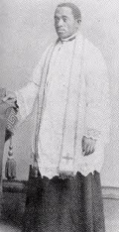 Reflection: I would like to introduce you all to a good spiritual friend of mine: Fr. Augustus Tolton, the first African American priest in the United States.
Reflection: I would like to introduce you all to a good spiritual friend of mine: Fr. Augustus Tolton, the first African American priest in the United States.
Augustus Tolton was born a slave in 1854 in rural, Missouri. He was baptized a Catholic at St. Peter’s Church in Brush Creek, Missouri. His father died right before serving in the Civil War. Wanting a better life for her children, Augustus’ mother escaped slavery with her three children forty miles east to Quincy, Illinois. There Augustus would find his calling as a Catholic Priest.
However, since he was black, no seminary in the United States would accept him. He was sent to the Propaganda Fide in Rome where he studied with seminarians from all over the world. As soon as he was ordained he asked to be placed as a missionary in Africa, but instead, he was sent back to his home parish in Quincy.
No matter where he went, his deep baritone voice would be heard by people of different cultures together in the same church. The other priests became jealous of Fr. Tolton’s popularity and made it impossible for him to stay in Quincy. Deeply heartbroken Fr. Tolton accepted his new mission in Chicago. There, he raised funds to build a church for the African American community. While funds were being raised, “the good Father Gus” as people called him, ministered all over the Chicago ghetto. Unfortunately, Fr. Tolton never got to see his church finished as he died of a heat stoke at the age 43.
Fr. Gus was truly a servant of God as he preserved time and time again. He once wrote to St. Katherine Drexel, “I shall work and pull at it as long as God gives me life for I am beginning to see that I have powers and principalities to resist anywhere and everywhere I go.” Even though Fr. Gus’ church was never finished, his spiritual legacy lives on in those who hear his story. He is a role model for all who are in the minority to follow God no matter the cost.
Prayer: ”O God, we give you thanks for your servant and priest, Father Augustus Tolton, who labored among us in times of contradiction, times that were both beautiful and paradoxical. His ministry helped lay the foundation for a truly Catholic gathering in faith in our time. We stand in the shadow of his ministry. May his life continue to inspire us and imbue us with that confidence and hope that will forge a new evangelization for the Church we love.” (from the Canonization Prayer)
Suggested Reading:
- A Biography of Fr. Gus by Fr. Roy Bauer
- Support Fr. Gus’ cause for canonization
Day 9 Saints Novena – Saint Joseph – by Bcoop
Saint Joseph and Christ Child icon by Michael O’Brien from Ontario Canada (www.studiobrien.com)
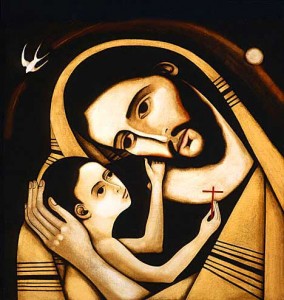 Reflection: Joseph of Nazareth is one of those hidden people in the Bible, but he played a big part in the lives of Jesus and Mary. He only appears in the Gospels of Matthew and Luke, first as an entry in the genealogy of Jesus and a link to King David’s line. He is mentioned as the husband of Mary and the father of Jesus. He was a carpenter in Nazareth. Matthew pictures him as a man who hears an angel’s message and protects his family from Herod’s wrath. Later, Luke tells the story about 12 year old Jesus in the Jerusalem Temple and his parents’ search for him. Then Joseph disappears from the scene.
Reflection: Joseph of Nazareth is one of those hidden people in the Bible, but he played a big part in the lives of Jesus and Mary. He only appears in the Gospels of Matthew and Luke, first as an entry in the genealogy of Jesus and a link to King David’s line. He is mentioned as the husband of Mary and the father of Jesus. He was a carpenter in Nazareth. Matthew pictures him as a man who hears an angel’s message and protects his family from Herod’s wrath. Later, Luke tells the story about 12 year old Jesus in the Jerusalem Temple and his parents’ search for him. Then Joseph disappears from the scene.
Perhaps the most important statement about Joseph in the Gospels is that he was a “just man”. That is, a person of integrity, of compassion, who is upright, sincere, and true. A person who lives in and for God, who is wise and learned in the Torah. Luke tells us that Jesus “grew in body and in wisdom, gaining favor with God and other people”. (Lk 2:52) I think he learned this along with carpentry at Joseph’s side.
Prayer:
Pray with us, Saint Joseph,
- patron of the Universal Church, teach us to walk in the Way of Jesus.
- patron of workers, help us to provide meaningful employment and adequate wages to all.
- refugee from Herod’s hatred, help us to be compassionate and open to those in trouble.
- father of your family, bless our families and teach us to live in love.
- teacher and guide for the child Jesus, help us to guide and support each other on life’s way.
Suggested Reading:
- The Bible
Please consider participating in A Nun’s Life fundraiser going on now through November 9. We need to raise $10,000 for much needed equipment and supplies. Donate at any time to support the mission of A Nun’s Life!
Archived Comments
- November 1, 2011 at 10:44 am
-
Beautiful meditation on Mary! We often fail to remember that she was first-of-all, “one of us” – a human being who lived a full human life.
- November 2, 2011 at 5:50 pm
-
I’m so often amazed and humbled by people who forgive wrongs that are so extreme and so far beyond my petty grievances. Thanks for sharing Josephine’s story.
- November 3, 2011 at 8:24 pm
-
Inspired writing SJ on Theresa Maxis Duchemin et al. “…even when it seems the struggles and trials that we bear are too much. We trust with Theresa and Louis, that God will bring all our efforts to good.” Thanks for the reminder timing couldnt have been better. I hadnt heard of Theresa Maxis Duchemin or Mother Theresa McGivney. There are so many saints with a variation of my name I cant believe it.
- November 4, 2011 at 1:47 pm
-
I have that comic book! (along with the John Paul II and Mother Teresa ones) Francis also did NOT write the Prayer of St. Francis make me an instrument of your peace, but it does echo his theology. I like to tell my college student about his pre-conversion party boy day, his dysfunctional relationship with his father and how his friends abandoned him when he was not “fun” anymore. I hope then they can find something else to relate to. Francis is more than a birdbath Thanks for writing!
- November 5, 2011 at 6:27 pm
-
So glad y’all are more than half way there. it’s an amazing ministry you do!! especially love the reflections on the saints Dominic n Francis are among my top ones
- November 6, 2011 at 1:41 pm
-
Oh, Oh, and OH! OH! Marla’s meditation is so powerful it has knocked me over! Will I be faithful? God help us to live that way. And die that way if need be.
- November 8, 2011 at 10:53 am
-
Father Tolton (sometimes known as Augustine Tolton) is a favorite of mine, as well. And, given that this is “ANunsLife,” I would like to remember in thanksgiving two important sisters in his life. First is Sister Herlinde Sick, SSND, who taught Tolton in primary school, fostered his vocation, tutored him in Latin, and later built a school for Black Catholics in Illinois. Second is Sister Caroline Hemesath, OSF, who wrote a full-length biography of him, “From Slave to Priest: The Inspirational Story of Father Augustine Tolton (1854-1897),” recently reprinted by Ignatius Press.
- November 9, 2011 at 12:04 am
-
Dorothy Day is one of my favorite saints – because she lived out her baptismal commitment without compromising her conscience – even when bishops disagreed with her. There’s a wonderful movie about her called “Entertaining Angels.” Martin Sheen played the part of Peter Maurin. Order it through Netflix.
- November 9, 2011 at 6:00 pm
-
To me its fitting that St. Joseph be the final saint recognized. He was the provider for the Holy Family. Why would he not be a benefactor and provider for ours here?
- November 9, 2011 at 10:29 pm
-
A couple of my books on the life of Fr. Augustus Tolton: “A Place for My Children” and a children’s book called “A Boy Called Gus.”
- November 12, 2011 at 6:16 pm
-
I recently had to choose a saint for a paper for one of my Theology courses and I chose Dorothy Day. While it was a hard choice in some ways, it was easy in the end because I believed that Dorothy was most like what Jesus would describe as a “saint” – a very real, very human person with all her faults out there, still plowing forward to follow Christ at all cost. I admire Dorothy because I cannot imagine having the strength of character to do what she did, but she keeps me trying. I think of her often each day now that I have gotten to know more about her. She had amazing courage and perseverence…I think she is a saint I would have really liked to have known, and I feel enriched by her life and her participation in the communion of saints which watch over and aid us each day.